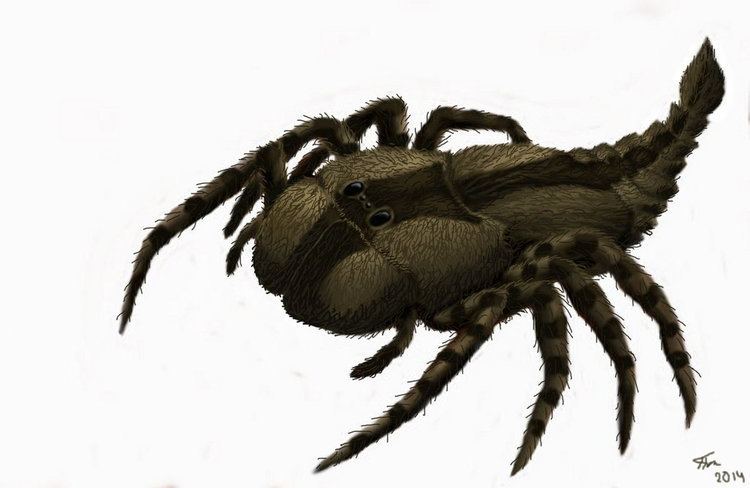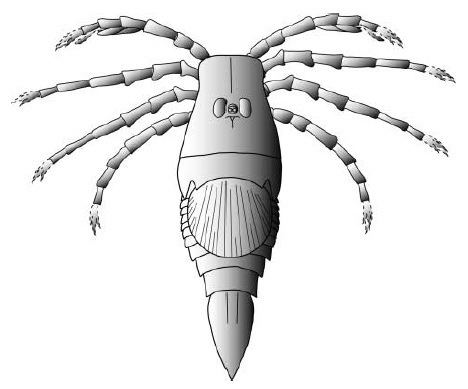Class Merostomata Species †M. servinei Order Eurypterid | Scientific name Megarachne servinei Rank Genus | |
 | ||
Similar Eurypterid, Megalograptus, Arthropleura, Hibbertopterus, Meganeura | ||
Sketchlesson ii megarachne
Megarachne servinei is an extinct eurypterid found in Upper Carboniferous (Pennsylvanian Gzhelian)-aged freshwater strata in San Luis, Argentina.
Contents
- Sketchlesson ii megarachne
- Ratskep mini meet megarachne servinei fossil
- Discovery
- Taxonomy
- In popular culture
- References
Ratskep mini meet megarachne servinei fossil
Discovery

Megarachne servinei was originally described in 1980 by the Argentinean palaeontologist Mario Hünicken. The holotype was recovered from the Pallero Member of the Bajo de Véliz Formation of Argentina, a locality dated to the Asselian Age (298.9 to 295 million years ago (Ma)). Hünicken wrongly identified the specimen as a mygalomorph spider based on the shape of the carapace, the 15 millimetres (0.59 in) wide circular eye tubercle located between the two eyes in the center of the head, a structure in front of the carapace he identified as spatulate chelicerae, and a circular structure behind the first body segment which he identified as the "moderately hairy" abdomen. Hünicken's identification relied heavily on X-ray microtomography of the holotype, and additional hidden structures were also extrapolated from the X-radiographs.

With a legspan estimated to be 50 centimetres (20 in), this would have made Megarachne servinei the largest spider to have ever existed, far exceeding the goliath birdeater (Theraphosa blondi) which has a maximum legspan of only around 30 centimetres (12 in). The discovery quickly became popular and various exhibits with reconstructions of Megarachne servinei as a gigantic spider were set up in museums around the world.
The identification of the specimen as a spider was doubted by some arachnologists. Even Hünicken himself acknowledged discrepancies in the morphology of the fossil that could not be accommodated with an arachnid identity. However, the holotype was by then deposited in a bank vault and other paleontologists had access only to the plaster casts.
In 2005, a second, more complete specimen was recovered from the same locality and horizon. A research team led by the British paleontologist and arachnologist Paul A. Selden and consisting of Hünicken and Argentinean arachnologist José A Corronca reexamined the holotype in light of the new discovery. They concluded that Megarachne servinei was not a spider, but was in fact, a large eurypterid, an extinct group of chelicerates more commonly known as "sea scorpions" and related to horseshoe crabs. A morphological comparison with other eurypterids indicated that Megarachne most closely resembled another large Permo-Carboniferous eurypterid, the hibbertopteroid Woodwardopterus scabrosus which is known only from a single specimen.
Taxonomy
Megarachne servinei is the only species classified under the genus Megarachne. Along with the genera Mycterops and Woodwardopterus, it is classified under the family Mycteroptidae, superfamily Hibbertopteroidea, suborder Stylonurina. The generic name of Megarachne comes from Greek for "giant spider".
In popular culture
A reconstruction of Megarachne servinei was slated to appear in the 2005 British documentary Walking with Monsters. Megarachne was to be depicted as a giant tarantula-like spider hunting cat-sized reptiles, following the information known about it when the series began production. The true identity of Megarachne as a eurypterid was only discovered well into production. By then it was too late to update the reconstructions. The scenes were left in, but the giant spider was instead recast for broadcast as an unspecified species belonging to the primitive spider suborder Mesothelae.
